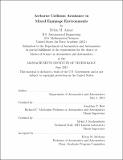Airborne collision avoidance in mixed equipage environments
Author(s)
Asmar, Dylan M. (Dylan Mitchell)
DownloadFull printable version (618.2Kb)
Other Contributors
Massachusetts Institute of Technology. Department of Aeronautics and Astronautics.
Advisor
Jonathan P. How and Mykel J. Kochenderfer.
Terms of use
Metadata
Show full item recordAbstract
Over the past few years, research has focused on the use of a computational method known as dynamic programming for producing an optimized decision logic for airborne collision avoidance. There have been a series of technical reports, conference papers, and journal articles summarizing the research, but they have primarily investigated two-aircraft encounters with only one aircraft equipped with a collision avoidance system. This thesis looks at recent research on coordination, interoperability, and multiple-threat encounters. In situations where an aircraft encounters another aircraft with a collision avoidance system, it is important that the resolution advisories provided to the pilots be coordinated so that both aircraft are not instructed to maneuver in the same direction. Interoperability is a related consideration since new collision avoidance systems will be occupying the same airspace as legacy systems. Resolving encounters with multiple intruders poses computational challenges that will be addressed in this thesis. The methodology presented in this thesis results in logic that is safer and performs better than the legacy Traffic Alert and Collision Avoidance System (TCAS). To assess the performance of the system, this thesis uses U.S. airspace encounter models. The results indicate that the proposed methodology can bring significant benefit to the current airspace and can support the need for safe, non-disruptive collision protection as the airspace continues to evolve.
Description
Thesis (S.M.)--Massachusetts Institute of Technology, Dept. of Aeronautics and Astronautics, 2013. This electronic version was submitted and approved by the author's academic department as part of an electronic thesis pilot project. The certified thesis is available in the Institute Archives and Special Collections. "June 2013." Cataloged from department-submitted PDF version of thesis Includes bibliographical references (p. 93-98).
Date issued
2013Department
Massachusetts Institute of Technology. Department of Aeronautics and AstronauticsPublisher
Massachusetts Institute of Technology
Keywords
Aeronautics and Astronautics.